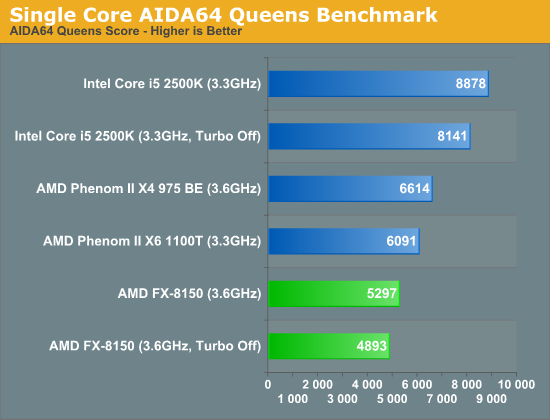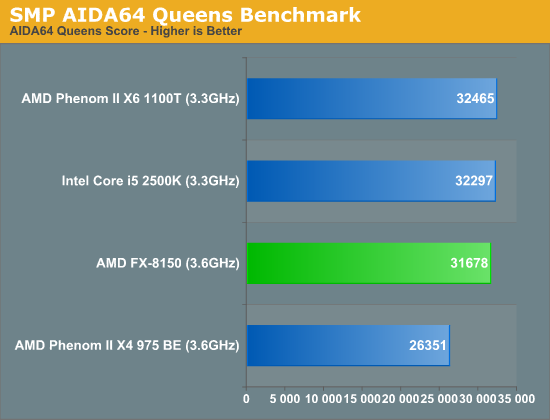The Bulldozer Review: AMD FX-8150 Tested
by Anand Lal Shimpi on October 12, 2011 1:27 AM ESTThe Impact of Bulldozer's Pipeline
With a new branch prediction architecture and an unknown, but presumably significantly deeper pipline, I was eager to find out just how much of a burden AMD's quest for frequency had placed on Bulldozer. To do so I turned to the trusty N-Queens solver, now baked into the AIDA64 benchmark suite.
The N-Queens problem is simple. On an N x N chessboard, how do you place N queens so they cannot attack one another? Solving the problem is incredibly branch intensive, and as a result it serves as a great measure of the impact of a deeper pipeline.
The AIDA64 implementation of the N-Queens algorithm is heavily threaded, but I wanted to first get a look at single-core performance so I disabled all but a single integer/fp core on Bulldozer, as well as the competing processors. I also looked at constant frequency as well as turbo enabled speeds:

Unfortunately things don't look good. Even with turbo enabled, the 3.6GHz Bulldozer part needs another 25% higher frequency to equal a 3.6GHz Phenom II X4. Even a 3.3GHz Phenom II X6 does better here. Without being fully aware of the optimizations at work in AIDA64 I wouldn't put too much focus on Sandy Bridge's performance here, but Intel is widely known for focusing on branch prediction performance.
If we let the N-Queens benchmark scale to all available threads, the performance issues are easily masked by throwing more threads at the problem:

However it is quite clear that for single or lightly threaded operations that are branch heavy, Bulldozer will be in for a fight.










430 Comments
View All Comments
Ryan Smith - Wednesday, October 12, 2011 - link
Good point. Fixed.Marburg U - Wednesday, October 12, 2011 - link
they have a bloating cache with something wrong insidehttp://www.xbitlabs.com/images/cpu/amd-fx-8150/t5....
npp - Wednesday, October 12, 2011 - link
Sun went an even more extreme route regarding FP performance on its Niagara CPUs - as far as I remember, the first generation chip had a single FPU shared across eight cores. Performance was not even close to a dual-core Core 2 Duo at that time. So that was what I though when I first read about the "module" approach in Bulldozer maybe an year ago - man, this must be geared towards server workloads primary, it will suffer on the desktop. I guess FPU count = core count would have be more appropriate for the FX line.hasu - Wednesday, October 12, 2011 - link
Would this be a good candidate for web server applications because of its excellent multi-threaded performance? How about to host a bunch of Virtual Machines?sep332 - Wednesday, October 12, 2011 - link
I've also been wondering if running a lot of VMs would work better on this CPU. But I don't really know how you'd benchmark that kind of thing. Time and total energy consumption to serve 20,000 web pages from 12 VMs?magnetik - Wednesday, October 12, 2011 - link
I've been waiting for this moment for months and months.Reading the whole thing now...
themossie - Wednesday, October 12, 2011 - link
This processor is worse than the Phenom II X6 for most of my workloads. My next machine will be Sandy/Ivy Bridge.But... we haven't seen this clock ramp up yet. As Anand mentions on page 3 - Remember the initial Pentium 4s? The Williamette 1.4 and 1.5 ghz processors were clearly worse than the competition, to say nothing of the PIII line. In time the P4 consistently beat the much higher IPC AMD processors on most workloads, especially after introducing Hyper-threading. This really does feel like a new Pentium IV! Trying a design based on clock speed and one-upping Intel's hyperthreading by calling 4 '1.5' cores 8 (we hyperthread your hyperthreading!) - it will be a wild ride.
At this point, I don't see anyone beating Intel at process shrink and they're a moving target. But competitive pricing, quick ramp up and a few large server wins can still save the day. Dream of crazy clockspeeds :-)
themossie - Wednesday, October 12, 2011 - link
Upon further reflection...- Expect to see Bulldozer targeted towards servers and consumers who think "8 cores" sounds sexy, at least until clockspeed ramps up.
- Processor performance is not the limiting factor for most consumer applications. AMD will push APUs very heavily, something they can beat Intel at. Piledriver should drive a good price/performance bargain for OEMs, and for laptops may have idle power consumption in shouting distance of Sandy Bridge.
I'm more optimistic about AMD now. But my next machine will still be Sandy Bridge / Ivy Bridge.
wolfman3k5 - Wednesday, October 12, 2011 - link
I see people that say that they'll be waiting for Piledriver. Why not wait for AMD Drillbit, or AMD Dremel? How about AMD Screwdriver or AMD Nailpuller? Tomorrow my 2600K arrives. I'm done. I had a build ready with a ASUS 990FX ready for Bulldozer, but I will "bulldoze" the part back to NewEgg.I must admit, I was worried when I saw the large amounts of L2 cache before the launch. AMD engineers must have been taking the summer off, and decided to throw more cache at the problem. AMD needs a new engineering team. Why the hell can Intel get it right and they can't?
AMD, your CPU engineers are lazy and incompetent. I mean, it only took you "only" four years to get your own version of the Pentium 4.
The bottom line is that its time to fire your lazy retarded and incompetent engineers, and scout for some talent. That's what every other company does that wants to succeed, regardless of the industry. I mean, look at KIA and Hyundai for example, they went out and hired the best designers from Audi and the best engineers they could buy with money. Throw some more money at the problem AMD and solve your problems. And if those lazy fat fucks in Texas that you call engineers don't deliver, look somewhere else. Israel or Russia maybe? Who knows... Just my 2 cents.
IKeelU - Wednesday, October 12, 2011 - link
I know nothing of AMD employee's work ethic, but...their problems may have nothing to do with raw technical talent. But you are right about one thing - throwing money at a problem can be helpful, and that's likely why Intel has succeeded for so long. Intel has a lot of cash, and a lot of assets (such as equipment). They can afford the best design/debugging tools (whether they buy'em or make'em), which makes it much easier to develop a top product given the same amount of microchip engineering talent.And just because they're based in Texas doesn't mean their staff is all-American. Like most US tech firms, quite a bit of their talent was probably imported.